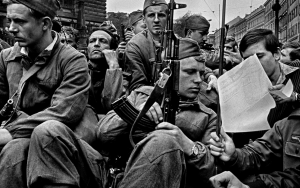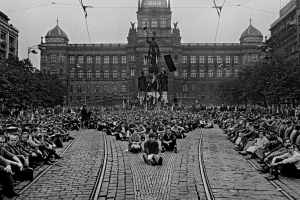50 Years After Prague Spring, Lessons on Freedom (and a Broken Spirit)
Source: The New York Times / www.nytimes.com / By Marc Santora /
PRAGUE — Could Soviet-style communism be reconciled with the dignity and freedom of the individual?
In 1968, the question was put to the test when the leader of Czechoslovakia’s Communist Party, Alexander Dubcek, initiated a project of liberalization that he said would offer “socialism with a human face.”
What followed was a rebirth of political and cultural freedom long denied by party leaders loyal to Moscow.

The free press flourished, artists and writers spoke their minds, and Mr. Dubcek stunned Moscow by proclaiming that he wanted to create “a free, modern and profoundly humane society.”
A season when hope and optimism were in bloom, it became known as the Prague Spring.
But nearly as soon as the movement came to life, it was crushed under the treads of Soviet T-54 tanks.
On Aug. 21, 50 years ago, the Soviet-led invasion of Czechoslovakia killed the dreams of the reformers, broke the spirit of a nation and ushered in an era of oppression whose effects are still felt today.
Moscow succeeded in restoring the supremacy of the state, but the ultimate cost of victory was high.
Perhaps more than any other event during the Cold War, the invasion laid bare for the world to see the totalitarian nature of the Soviet regime.
The photographs of unarmed citizens confronting columns of heavily armed soldiers, pleading, “Ivan, go home,” made it clear to the world that this was an ideology that needed to be enforced at the point of a gun.
Many of the most famous images were taken by Josef Koudelka, who was on the streets with his Exakta camera loaded with film that he had cut from the end of exposed movie reels.
Mr. Koudelka’s pictures were smuggled out of Prague and published anonymously, credited only to “Prague Photographer.”
In their intimacy and vivid detail, putting viewers on the street with shocked and horrified citizens, they showed the propaganda flowing from Moscow — that troops were sent to restore order and had been welcomed by the people — as utter lies.
“It was a defining moment,” said Jiri Pehe, a former political adviser to Vaclav Havel, the first president of post-Communist Czechoslovakia and now the director of New York University in Prague.
“For the country, it was a defining moment because after a huge rise in the hopes of the people and an outburst of creative energy, the country was crushed,” Mr. Pehe said. “It really broke the backbone of the nation.”
Mr. Pehe was 13 at the time. He can still recall the shock of the moment — and not just the violence and chaos.
“I still remember people going to the tanks and going to the soldiers, and talking to the soldiers who did not even know where they were, they were saying: ‘This is a terrible mistake. What are you doing here? Why did you come?’ ” he recalled.
“We were young kids,” he added. “And like all of my other schoolmates, we were raised with this idea that the system might have problems, but that it was a humane system. This was drummed into us. After 1968, this all ended. We realized this was all lies.”
With the benefit of hindsight, it may now seem obvious that the countries that fell under the sphere of Soviet influence after World War II were doomed to fall victim to Stalinist oppression.
But that was the bargain reached at the end of the war, when Europe was essentially cut in half.
“From Stettin in the Baltic to Trieste in the Adriatic, an iron curtain has descended across the Continent. Behind that line lie all the capitals of the ancient states of Central and Eastern Europe,” Winston Churchill warned in a 1946 speech.
“Warsaw, Berlin, Prague, Vienna, Budapest, Belgrade, Bucharest and Sofia, all these famous cities and the populations around them lie in what I must call the Soviet sphere,” he said, “and all are subject in one form or another, not only to Soviet influence but to a very high and, in many cases, increasing measure of control from Moscow.”
When citizens fought back in nations under the Soviet yoke, such as East Germany in 1953 and Hungary in 1956, the rebellions were brutally crushed.
But the Prague Spring was different.

It was not an attempt to overthrow the communist regime, but rather one to transform it.
But Moscow viewed events in Czechoslovakia as something like a virus, fearing they would spread and infect other Warsaw Pact nations, according to documents unearthed by a committee of scholars with the help of the National Security Archive, a nongovernmental group in Washington, and published in “The Prague Spring ’68.”
Leonid I. Brezhnev, the Soviet leader, comes across as particularly incensed by the criticisms leveled at the Soviet system by a newly free and emboldened news media. Among the first targets of the invading troops were the Prague radio and television stations.
American intelligence agencies watched with concern as troops amassed near the borders of Czechoslovakia, but the invasion caught the administration of President Lyndon B. Johnson by surprise. There was little Western nations could do. Some 250,000 troops from 20 Warsaw Pact divisions swept across Czechoslovakia, with 10 Soviet divisions filling the positions they vacated.
They were backed by thousands of nuclear weapons pointed at Western and Central Europe.
“Nothing short of a world war was likely to get them out,” was the judgment of a review of the C.I.A.’s handling of the crisis. “In 1938, the Western powers had responded to threats against Czechoslovakia by backing down, rather than face Nazi Germany they falsely believed was ready for war. In 1968 they had no choice.”
It was one more chapter in a remarkable year around the world, marked by tragedy, turmoil and triumph. Students on college campuses from Paris to Berkeley, Calif., were in revolt. The assassinations of Robert F. Kennedy and the Rev. Dr. Martin Luther King Jr. left America shattered and bitterly divided. The Vietnam War raged on even as Apollo 8 soared into the heavens, becoming the first manned spacecraft to orbit the moon.
For the millions living under the heel of invading forces in Czechoslovakia, the shift from hope to despair was as swift as it was shocking.
By 7:45 a.m., according to press reports at the time, Soviet-led forces had shot unarmed civilians gathered in protest.
Confusion quickly turned to anger and desperation, as tens of thousands of civilians — young and old alike — gathered in the grand plazas of Prague, Bratislava and other major cities.
They had no weapons, only defiance.
As the chaos spread, some pleaded with the soldiers — many of whom were as bewildered as the people on the streets, as they had been told that they were to stop an insidious counterrevolution, only to be greeted with scorn.
The most violent episode took place outside the Prague radio station, the city’s only major fountainhead of defiance. In an attempt to keep broadcasting, protesters moved city buses around the building and set them ablaze. When Soviet tanks rammed the fortifications, several set themselves on fire.
It is still unclear how many people died during the invasion, with estimates ranging from 80 to several hundred. But in the months that followed, as scores of people were arrested and thousands sent for “re-education” under a program of “normalization,” hope was replaced by fear and defiance with dejected resignation.
That despair was captured most drastically on Jan. 16, 1969, when Jan Palach, a student at Charles University in Prague, went to Wenceslas Square and set himself on fire in protest — a moment captured on film. He died several days later, and thousands attended his funeral.
Others would imitate his self-immolation, but the Prague Spring was over. The Stalinist winter would last two decades.
Jirina Siklova, a sociologist in Prague who was a member of the Communist Party before the invasion, said that in the 1960s, she would frequently travel abroad and talk to curious students who viewed the socialist system as a possible cure to what ailed their own societies.
That notion died when the tanks rolled into Prague and more than 100 civilians were killed.
“After the invasion, I never met anybody who would advocate it, not even among the Soviets,” she said. “Fifty years later, we still have not found any alternative to fighting problems of the Western world, and that is why many people turn to extremists.”
Indeed, Europe finds itself more divided than at any point since the end of the Cold War. Bedrock institutions of the postwar order, such as NATO, have come under questioning from an American administration inherently suspicious of alliances.
The events that played out 50 years ago in Prague serve as a reminder of the fragility of the systems created to guard against war and tyranny.

